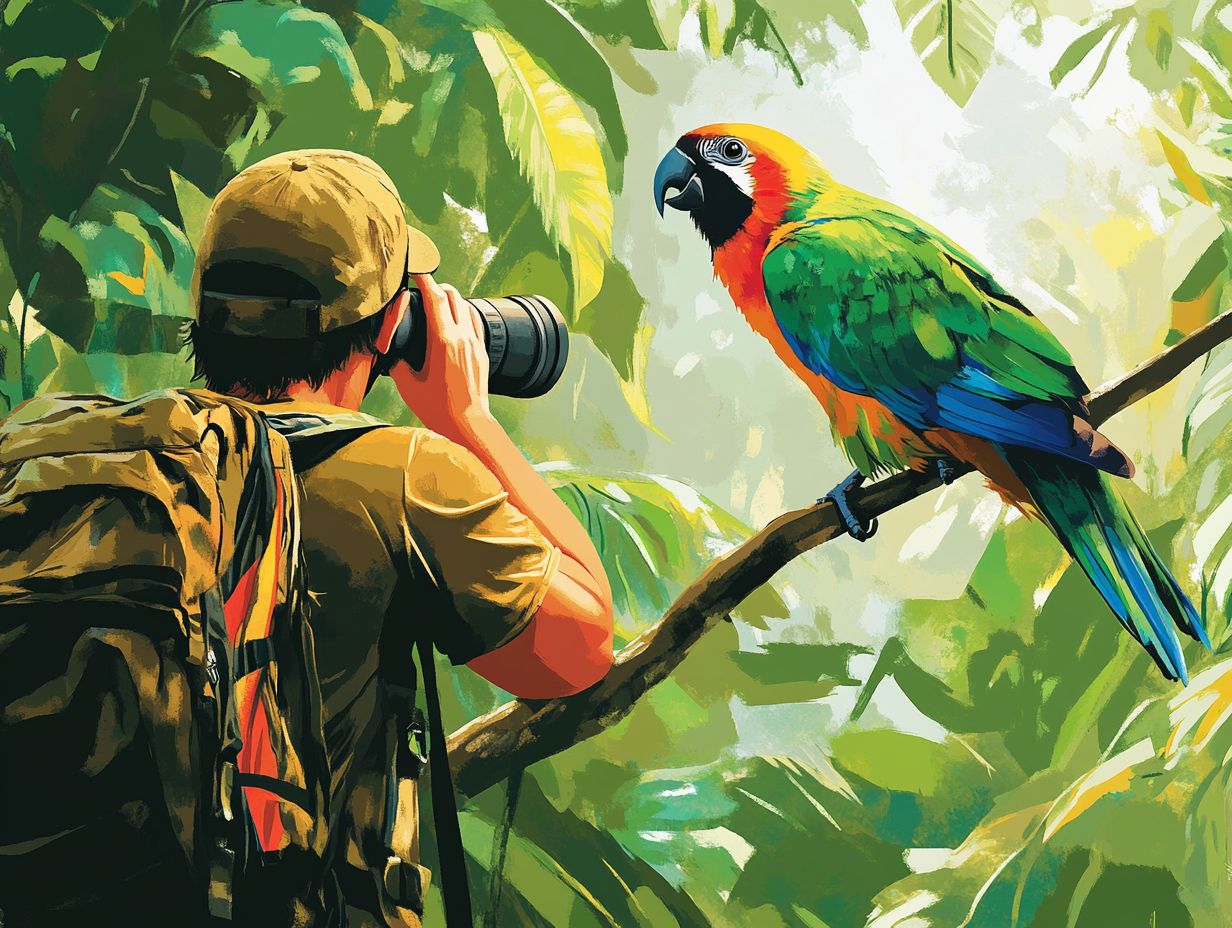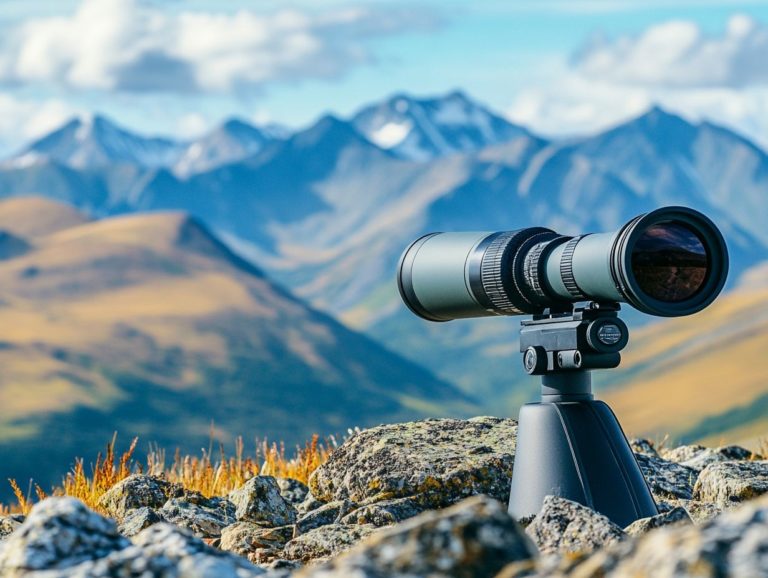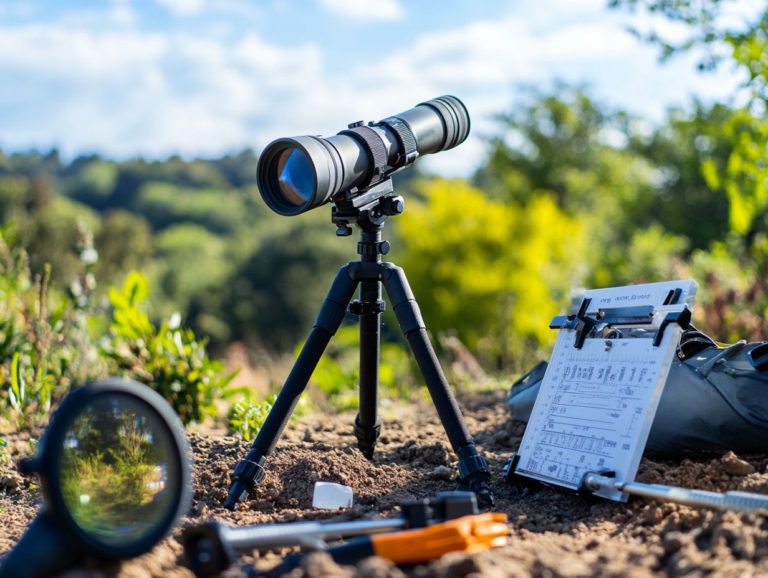5 Expert Tips for Spotting Hard-to-Find Birds
Birdwatching can be an exhilarating adventure, especially when you pursue elusive species like the Cape May Warbler or American Robin. Whether you re a seasoned bird enthusiast or just starting your journey, knowing where to look and how to attract these feathered friends can significantly enhance your experience.
Here are five tips to help you spot hard-to-find birds. We ll cover their preferred habitats, the art of using bird calls, and more. You will discover common pitfalls to avoid, essential tools to have on hand, and some birding basics along with lesser-known techniques to refine your skills.
Get ready to transform your birdwatching experience!
Contents
- Key Takeaways:
- 1. Know the Habitat of the Bird You Are Looking For
- 2. Use Bird Calls and Songs to Attract Them
- 3. Look for Clues in the Environment
- 4. Be Patient and Observant
- 5. Join a Birding Group or Hire a Guide
- What Makes Some Birds Hard to Find?
- Frequently Asked Questions
- What are some expert tips for spotting hard-to-find birds?
- What are some common mistakes to avoid when trying to spot hard-to-find birds?
- How can I improve my chances of spotting hard-to-find birds?
- What should I bring with me when going birding?
- Are there any safety precautions I should take when birding?
Key Takeaways:

- Know the bird’s habitat for better spotting chances.
- Use bird calls to attract shy species.
- Look for signs in the environment to aid your search.
1. Know the Habitat of the Bird You Are Looking For
Understanding the bird’s habitat is key to successful birdwatching. Different species, like the Blackpoll Warbler and Common Yellowthroat, have specific habitat preferences that reflect their breeding and feeding habits.
For example, visiting places like Garret Mountain Reservation or Mount Auburn Cemetery can lead to sightings of both common and rare birds. Knowing these habitats enhances your appreciation of the seasonal movement of birds and provides a clearer picture of the flocks that inhabit them during various weather conditions.
These diverse habitats, from dense woodlands to open wetlands, attract many species while providing necessary resources for survival and reproduction. Observing where species like the Northern Parula or Prothonotary Warbler nest and forage deepens your understanding of bird behavior.
Using field guides and platforms like eBird is essential for identifying local species and their preferred habitats. These resources will help you document your findings, keep you informed about seasonal changes, and allow you to contribute to citizen science initiatives. Engaging in these activities will enrich your experience during the spring migration.
2. Use Bird Calls and Songs to Attract Them
Using bird calls and songs can be a game-changer in attracting various bird species during migration. This significantly enhances your birdwatching experience! Tools like Merlin Bird ID are invaluable for identifying specific calls, making it easier to draw in elusive songbirds.
By understanding the timing and context of these songs, you can set yourself up for more successful encounters, especially in spring during songbird migration. The air fills with their vocalizations as they prepare for the breeding season.
Being intentional about your outings increases your chances of spotting these beautiful creatures. It also deepens your appreciation for their diverse vocalizations. Observing the differences between a warbler s cheerful trills and a thrush s melodious calls enriches your identification skills.
For those eager to learn, apps like Merlin Bird ID and BirdCast help you recognize specific calls and offer tips on the best times and places to listen. Think early mornings in woodlands or near water sources when birds are most active. This informed approach elevates your joy of birdwatching and fosters a deeper connection with the natural world.
3. Look for Clues in the Environment
Observing subtle clues in your surroundings can significantly elevate your birdwatching experience. This leads to more rewarding sightings and a greater understanding of bird behaviors. Factors such as weather conditions, the presence of specific plants, and even the composition of bird flocks can hint at the likelihood of encountering particular species.
By tuning in to these environmental signals, you can ethically navigate bird habitats. This ensures minimal disturbance while deepening your comprehension of their behaviors and habitats.
Listen closely to the enchanting calls and songs that often reveal the species and their activities in your vicinity. Look for telltale signs like feathers, nests, or droppings. These clues can offer valuable insights into bird activity around you.
Practicing ethical birdwatching is crucial. Maintaining a respectful distance helps reduce stress on both the birds and their environment. This is part of good birding ethics. When documenting your sightings, consider using a journal or an app to capture not just the species and numbers observed, but also the context, such as location and weather conditions.
Including any noteworthy behaviors enriches your experience and fosters a profound understanding of avian life.
4. Be Patient and Observant

Patience and keen observation are essential traits for you as a birdwatcher, especially when watching warblers or trying to spot elusive species among common birds. The art of birdwatching demands that you remain still and quiet. This allows you to notice subtle movements and sounds, particularly those of various warblers that might escape others.
This attentiveness is crucial for identifying both common and rare birds across diverse environments. It enhances your appreciation of their intricate behaviors.
By slowing down your observations, you can truly immerse yourself in your surroundings. This transforms a simple outing into a rewarding adventure. For example, consider a seasoned birder who once spent hours in a lush woodland. The gentle rustling of leaves eventually revealed the enchanting sight of a Golden-winged Warbler or even a cedar waxwing.
This moment wasn t merely about spotting a rare bird. It stemmed from unhurried moments filled with background sounds and soft colors. This highlights how patience often leads to breathtaking encounters.
Through such experiences, you ll discover that simply being present brings its own profound rewards.
5. Join a Birding Group or Hire a Guide
Joining a birding group or hiring a guide can elevate your birdwatching experience. It gives you access to insights from seasoned experts like Chris Wood and Jessie Barry. They share local forecasts and recent bird sightings.
These groups create vibrant communities that deepen your understanding of bird behavior. By learning from others, you cultivate birding ethics that promote a more sustainable way to enjoy nature.
Engaging with fellow bird enthusiasts expands your social network and enriches your appreciation for avian diversity. These groups often organize outings that offer you the chance to observe various species in their natural habitats. This amplifies the joy of discovery.
To find local birding groups, tap into online platforms or check community boards. Many enthusiasts post upcoming events. You can expect these experiences to be filled with camaraderie and shared excitement. They often lead to educational workshops that sharpen your skills in identification and photography.
Each excursion becomes not just a trip, but a valuable learning adventure. Join a local birding group today!
What Makes Some Birds Hard to Find?
Certain birds, especially rare species and specific warblers during migration, can be quite the challenge to locate. Various factors influence their behavior and visibility, making the quest for these feathered wonders both thrilling and frustrating.
Migration patterns are crucial; some birds might only grace an area for a fleeting moment or blend seamlessly into their surroundings, complicating identification. Habitat loss, unpredictable weather conditions, and their instinctual tendencies to evade human presence only add to their interesting behavior.
To enhance your chances of spotting these captivating creatures, consider a few effective strategies. First, familiarize yourself with the specific habitats and behaviors of rare birds like the Blackpoll Warbler. For instance, knowing what to do when you spot a rare bird can help you locate them in dense thickets or wetland areas, where they seek food or shelter.
Using tools like binoculars can significantly enhance your visibility, making it easier to catch a glimpse of these beautiful birds as they flit through their natural environment. Bird identification apps provide invaluable insights, helping you decode calls and songs to recognize birds by their unique sounds.
What Are Some Common Mistakes When Trying to Spot Hard-to-Find Birds?
Many birdwatchers, particularly those just starting out, often stumble into common pitfalls when it comes to spotting elusive birds. They frequently fail to appreciate the importance of studying habitat and understanding the local bird flocks around them. To avoid these mistakes, consider following these tips to choose the right birding app. Underestimating the power of patience and keen observation can lead to disappointment.
Charging into a new environment without grasping the specific behaviors or habitats of your target species can result in missed chances for remarkable sightings. If you fail to identify the distinguishing traits of both common and rare birds, your success rate will inevitably drop.
This often arises from insufficient preparation; novice birdwatchers may not dedicate enough time to researching their subjects or the locales they intend to explore. A lack of understanding about bird-related behaviors can also impede your efforts, making it challenging to predict movements or feeding habits.
To combat these missteps, get acquainted with the local flora and fauna to recognize ideal habitats. Sharpening your observation skills through patient watching will significantly boost your chances of spotting birds. For beginners, consulting field guides for new bird watchers can provide valuable insights, as many birds only reveal themselves to those who are willing to wait quietly.
What Are the Best Times and Seasons to Spot These Birds?

Timing is everything for spotting elusive birds! The right season and weather can make all the difference. During migration periods, especially in spring, you ll find many species, like warblers, flocking together making it the perfect time for birdwatching.
By familiarizing yourself with local migration patterns and keeping an eye on weather forecasts, you can gain invaluable insights into the best moments to immerse yourself in nature.
Consider this: rain can actually boost activity among certain species, luring them to feeding areas where insects become more plentiful. Plan your birdwatching trips during overcast days or right after a storm; these conditions often lead to a more rewarding viewing experience.
Pay attention, and you ll notice that early mornings and late afternoons are typically when birds are most animated. Synchronizing your visits with these natural rhythms can significantly enhance your chances of encountering a diverse array of migrating species.
Grab your binoculars and get ready for an adventure in birdwatching!
What Are Some Essential Tools for Birdwatching?
Having the right tools for birdwatching is crucial, whether you re a novice or a seasoned birder. The right tools significantly enhance your experience and success in identifying those feathered friends.
Field guides and handy smartphone applications are important. Investing in quality binoculars is vital, too. Binoculars allow you to observe distant species with remarkable clarity. Their unique features, such as magnification (how much closer you can see an object) and field of view, help you immerse yourself in the fascinating behaviors of birds without disrupting their natural habitat.
Bringing a notebook for jotting down observations can enrich your birdwatching journey. This practice encourages reflection and deepens your learning with each sighting. Together, these tools cultivate a stronger connection to nature, transforming casual outings into enriching adventures that ignite your curiosity and appreciation for the avian world.
How Can One Improve Their Bird Spotting Skills?
Improving your bird spotting skills is a gradual journey requiring dedication, patience, and keen observation—essential ingredients for successful birdwatching. Regular practice in different environments helps you become familiar with various species and their behaviors. To enhance your experience, consider using 5 must-have field guides for birding enthusiasts, which ultimately enhances your ability to identify and locate birds in the field.
Engaging with experienced birders and seeking their feedback can provide valuable insights that significantly contribute to your skill development. To further refine your observation skills, dedicate time to specific exercises, like honing your binocular usage or participating in local bird counts.
Keeping a journal of your sightings with detailed notes sharpens your memorization and recognition capabilities. Utilizing community resources like workshops and online forums allows you to gain knowledge and ask questions in a supportive environment.
Mentorship from seasoned birdwatchers enhances your learning experience and fosters a sense of community. This makes your journey into bird spotting both enriching and enjoyable.
What Are Some Lesser-Known Techniques for Finding Hard-to-Find Birds?
Exploring lesser-known techniques for uncovering elusive birds can elevate your birdwatching game. This becomes especially useful when hunting for rare species during migration. For instance, employing playback of bird sounds can draw in specific species, while understanding bird behavior may lead to more sightings.
Keeping an eye on local environmental shifts and adjusting your methods is crucial for a fruitful birdwatching experience. Consider using mobile apps with detailed maps and extensive bird-call libraries. These tools help you pinpoint bird hotspots based on recent sightings.
Research shows that using visual decoys that mimic the plumage or size of sought-after birds can deceive even the wariest avians. Seasoned birdwatchers often share that maintaining silence and blending into your surroundings can make a world of difference, reducing disturbances in the habitat.
These subtle yet powerful tactics showcase how a dash of innovation paired with patience can lead to unforgettable encounters with elusive feathered friends.
Frequently Asked Questions

What are some expert tips for spotting hard-to-find birds?
- Start by researching the specific bird species you want to spot. Learn about their habitat, behavior, and typical sightings to increase your chances of finding them.
- Use a birding app or field guide to familiarize yourself with the bird’s appearance, call, and flight pattern before heading out to spot them.
- Look for areas with dense vegetation, as many elusive birds prefer to hide in thick foliage. Be patient and observant, as they may reveal themselves with movement or calls.
- Use your ears as much as your eyes, as some birds may be easier to spot by their distinct calls than by their appearance.
- Consider joining a local birding group or hiring a professional guide, as they can offer valuable tips and knowledge about the best locations and techniques for spotting rare birds.
What are some common mistakes to avoid when trying to spot hard-to-find birds?
1. Don’t be too loud or make sudden movements. This can scare birds away. Move slowly and quietly. Use binoculars or a long lens to observe from a distance.
2. Don’t rely only on your camera or phone. Looking through a lens can limit your view and cause you to miss other birds.
3. Be patient! Some birds take time to show themselves. Keep searching and don t give up too quickly.
4. Respect the birds’ space. Avoid getting too close to their nests or feeding areas.
5. Don t trust vague rumors about rare birds. Always do your own research to verify sightings before you head out.
How can I improve my chances of spotting hard-to-find birds?
1. Follow birding etiquette. Respect the natural habitat of birds.
2. Pay attention to the weather and time of day. Some birds are active during specific conditions.
3. Use binoculars or a spotting scope for a better look without disturbing the birds.
4. Stay flexible. You might not find the exact bird you want, but you could discover other interesting species!
5. Don’t hesitate to ask experienced birders for tips. They might have valuable insights that can help you spot rare birds.
What should I bring with me when going birding?
1. Bring binoculars or a spotting scope. These tools are essential for observing birds from a distance.
2. Use a field guide or birding app. This will help you identify the birds you see.
3. Pack a notepad and pen. Taking notes can be helpful for recording your sightings.
4. Dress appropriately for the weather. Wear comfortable shoes for walking and standing.
5. Don t forget snacks and water. Staying hydrated and nourished is important while outdoors!
Are there any safety precautions I should take when birding?
1. Always be aware of your surroundings. Watch for hazards like uneven ground or wildlife.
2. Never trespass on private property without permission.
3. Use insect repellent to avoid bug bites and wear sunscreen to protect your skin.
4. Inform someone about your plans. Let them know where you re going and when to expect you back.
5. If you re birding alone, consider bringing a whistle for emergencies.






